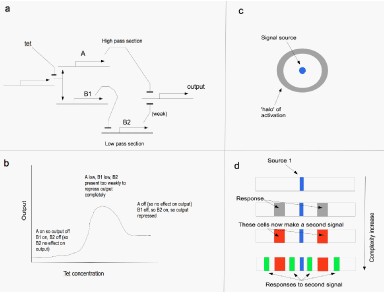
 |
| Figure 2: Synthetic band-pass filters as potential patterning elements. (a) depicts the architecture of the system built by Greber & Fussenegger [44], which is based on two separate pathways that can each inhibit the production of the output molecule. The top pathway, on its own a high-pass filter, makes molecule A to repress the production of output molecule unless tetracycline (tet) is present at high enough concentrations to inhibit production of A. The bottom pathway, a low-pass filter, includes an extra inverting step so that in the absence of tet, B1 is made and represses the production of B2 so there is no B2 to repress the output (the promoters of B2 and the output are ‘on’ unless repressed, the promoters of A and B1 are off unless activated). When tet is present, B1 is repressed and B2 is made. B2 is a less potent repressor of the output than is A, so that there is a window of tet concentration that suppresses A enough to allow some production of output and represses B1 enough that some B2 is made, but not enough to completely suppress the output either. (b) The circuit therefore allows production of significant output over a narrow band of tet concentration. (c) If tet (or some other signalling molecule in an appropriately modified version of the circuit) were present in a gradient from one source, the band-pass filter would result in the production of the output in a halo around that source. (d) If the output were itself a signal that diffused less rapidly, and a second band-pass circuit responsive to this signal were present, another layer of detail would be added to the pattern. In this way, synthetic circuits could pattern tissues and, in principle, control location-dependent differentiation of cells. |